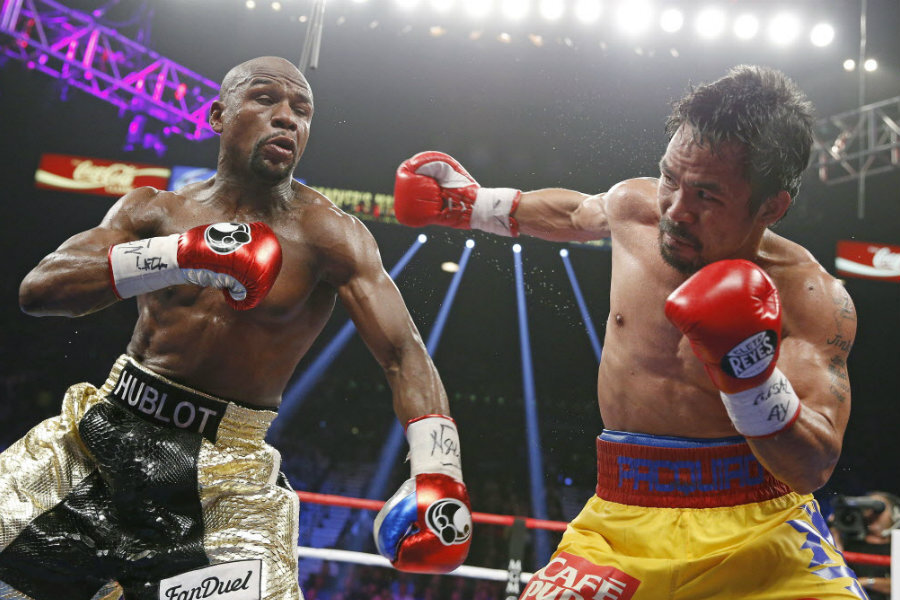Mayweather-Pacquiao fight: Did pay-per-view debacle deal another blow to cable?
Loading...
In the hours and minutes leading up to what was billed as “The Fight of the Century,” viewers across America howled at their television screens – not out of excitement, but out of frustration.
Boxing fans, many of whom had waited five years for the May 2 match between champions Floyd Mayweather, Jr. and Manny Pacquiao, were forced to endure a 45-minute delay in coverage as the nation’s top cable and satellite providers struggled to bring pay-per-view service to what was expected to be a record audience of more than 2.5 million households. The incident sparked a social media uproar among disgruntled viewers, adding to already growing overall customer dissatisfaction with US cable companies.
The outages affected Comcast Xfinity, Time Warner Cable, DirecTV, Dish, Charter, AT&T, Cox, and Optimum, according to culture and entertainment site Deadline. Customers also reported issues with Verizon, Brighthouse, RCN, and Cablevision. The fight cost $90 to $100 on pay-per-view.
The service troubles led some frustrated subscribers to turn to Twitter’s video-streaming app Periscope to watch the fight, in direct defiance of anti-piracy efforts by HBO and Showtime, the two networks behind the coverage, Yahoo! News reported.
Periscope lets users stream live video from their mobile phones, “and if one happened to point that phone at a broadcast of the fight, then anyone in the world could tap in for free,” wrote Yahoo! sports writer Jay Busbee.
“Of course, the video quality was roughly equivalent to an old VCR tape, and the audio picked up whoever happened to be in the same room cheering for the fight,” he added, “but free was free.”
The cable companies acknowledged the problems and urged viewers to be patient, saying that the high volume of orders was causing the delay.
The fight eventually aired: 12 rounds of feints, jabs, and clinches that ended in a victory by unanimous decision for Mr. Mayweather and will leave both boxers each about $100 million richer.
Still, the issues surrounding the fight’s cable service highlighted the troubles of an industry that is widely maligned. Last year, Time Warner Cable’s Internet service provider placed last in the University of Michigan’s 2014 American Consumer Satisfaction Index, which ranks 230 household brands based on more than 70,000 annual interviews.
Time Warner scored 54 out of a 100, followed closely by the company’s subscription television service, which scored 56.
Comcast fared little better, a result that stems from an organization where “customer service has been replaced by an obsession with sales; technicians are understaffed while tech support is poorly trained; and the company is hobbled by internal fragmentation,” according to The Verge.
On top of that is the threat of streaming services such as Netflix and Amazon: 5 million cable TV subscribers dropped their service over the past five years in a shift that, experts say, resembles how phone wires have slowly been replaced by mobile phones over the years, The Christian Science Monitor reported last July.
Could this pay-per-view debacle mark the end for cable companies?
Not quite yet, it seems. The fight itself should prove to be a substantial moneymaker – 30 to 40 percent of the expected $270 million in pay-per-view sales have been set aside for cable and satellite providers, Business Insider reported.
And despite their gripes about cable TV, consumers have yet to cut the cord completely. According to a 2012 report by Nielsen, more than 90 percent of US households pay for TV. The media consumer research company released a report last month on subscription video on-demand (SVOD) services; the company found that 93 percent of households that have cable, broadband, and SVOD are less likely to drop cable than the other two, Media Life magazine reported.
“While it is obvious that we are in the midst of a rapid transformation... it also seems clear that viewers have not completely abandoned what we call the TV set in search of new ways to feed their content cravings,” David Ernst, vice president for cross-platform media at Discovery Communications, wrote in a company blog. “The fact that viewers still enjoy the habitual nature of television would suggest that future changes in behavior will be more evolutionary than revolutionary.






